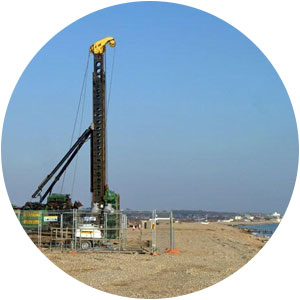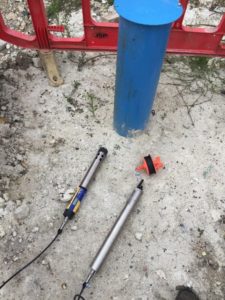 WHS can ensure that piled foundations and penetrating ground improvements present no risk to controlled waters.
WHS can ensure that piled foundations and penetrating ground improvements present no risk to controlled waters.
Piled foundations and penetrating ground improvements can affect controlled waters
Depending on ground conditions and development loads, some foundations need to be supported on piles or geotechnical improved ground.
On brownfield sites, piling works risk assessments (PWRA) may be required by either the Local Planning Authority (LPA) or Environment Agency (EA) for such developments. These form part of the planning application process (added planning condition) and ensure that potentially mobilised contaminants present no risk to controlled waters.
Environmental regulations and guidance
The potential environmental and human-health risks associated with different piling techniques are outlined in the EA guidance document ‘Piling and penetrative ground improvement methods on land affected by contamination: Guidance on pollution prevention’ (2001).
Six pollution scenarios are listed, highlighting specific risks that piling or penetrative ground improvement operations may present to receptors.
- Creation of preferential pathways through a low-permeability layer (an aquitard), allowing potential contamination of an underlying aquifer.
- Upward migration of gas from landfill or soil, or contaminant vapours to the surface via preferential pathways through a low-permeability surface layer.
- Direct contact of site workers and others with contaminated soil arisings which have been brought to the surface.
- Direct contact of the piles or engineered structures with contaminated soil or leachate causing degradation of pile materials (with secondary effects of increasing potential contaminant migration).
- The driving of solid contaminants down into an aquifer during pile driving.
- Contamination by concrete, cement paste, or grout of groundwater and, subsequently, surface water.
Chalk aquifers
A pollution scenario not specifically addressed in the guidance relates to piling into chalk aquifers.
- Contamination of groundwater and, subsequently, public water supply well by suspended solids (enhanced turbidity).
Piled constructions above chalk aquifers must include an assessment of the potential pollutant risk associated with enhanced groundwater turbidity.
Turbidity is an optical measure of water clarity, measured in nephelometric turbidity units (NTU). Suspended particles in the water reduce water clarity by scattering light, so waters with high turbidity appear cloudy, murky or coloured.
Drinking water turbidity should be less than 5 NTU and ideally below 1 NTU, according to the World Health Organization (WHO).
In the UK, the maximum turbidity of drinking water is set at 4 NTU (measured at the consumer’s tap). Water companies often set the limit at 1 NTU at the pumping well because turbidity interferes with water sanitation measures.
In recent years the importance of turbidity in well waters has increased. Wells often yield waters with particle concentrations that are well above drinking-water standards, but which vary in a complex manner with pumping rates and other hydrogeological conditions.
Piling works can increase turbidity directly, in the vicinity of the pile location.
Any increases in turbidity are limited in time and space. Drilling in weathered chalk (putty chalk) generates suspended particles (solids) that either precipitate again locally under low-flow conditions, or can get flushed into higher permeable zones, where the pile/drilling location is connected to the fracture network.
Continuous flight auger (CFA) piling
CFA piling is the quietest form of piling, with low impact on the surrounding environment.
CFA is a cast-in-situ process, very suited to soft ground where deep casings or use of drilling support fluids might otherwise be needed. It is a non-displacement piling system, meaning the soil excavated from the pile is brought to the surface. CFA piles can be an attractive alternative to conventional bored piles (faster installation) and driven piles (much less noise and vibration).
The key features and benefits to CFA piling are:
- material is removed from the ground along the auger flights, removing potentially impacted material instead of simply forcing it out vertically or horizontally, and minimising the potential for a plug of contaminated soil being driven into the main aquifer body.
- it commonly involves concrete being introduced under pressure when the auger is withdrawn from the hole, so preferential pathways and voids are not formed along the soil/concrete interface.
- concrete piles inhibit the flow of mobile contaminants through the structure.
CFA poses ‘the least risk of groundwater pollution, although even these will not be acceptable at some sites without further precautions such as the removal of contaminated material from individual pile site or the use of temporary casing to seal out contaminated water’ (Environment Agency, 2001).
It is essential piles are well constructed to prevent the creation of voids along the length of foundations.
Turbidity mitigation measures
WHS has successfully negotiated groundwater quality monitoring for turbidity before, during and after piling works, as part of mitigation measures to provide assurance to stakeholders (eg. LPA, EA, water company).
Monitoring wells at least 5m deeper than the deepest pile proposed are installed in the appropriate response zone, ensuring they capture any impacts of the proposed groundworks.
Continuous turbidity monitoring, remote sensing and agreed trigger values provide assurance that locally generated turbidity has low impact on sensible controlled water receptors.
Where trigger values/criteria are reached or exceeded, the values can be put into context with the activities that took place on site (for instance piling, equipment moved or water sample taken). Piling location and frequency are then re-evaluated and can be adjusted as needed to reduce localised turbidity. Remote sensing also allows immediate stakeholder notification.

AquaTROLL600 turbidity and remote sensor installation at groundwater monitoring well.
When to address the issue of turbidity
Water quality monitoring is best included in the early construction design stage. This allows for sufficient time to collect baseline water quality monitoring data and seasonal data on water levels.
A detailed hydrogeological conceptual site model is central to all hydrogeological risk assessments and successful compliance with planning application conditions.
The last word
WHS Water Services provides qualitative and quantitative hydrogeological risk-assessment services for controlled waters.
We have detailed knowledge and understanding of catchment hydrology, hydrogeology, environmental impact assessment.
Most importantly, we know how the regulators work.